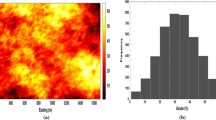Abstract
This paper presents a modified ordinary kriging technique referred to as the “Area Influence Kriging” (AIK). The method is a simple and practical tool to use for more accurate prediction of global recoverable ore resources in any type of deposit. AIK performs well even in deposits with skewed grade distributions when the ordinary kriging (OK) results are unreasonably smooth. It is robust and globally unbiased like OK. The AIK method is not intended to replace OK, which is a better estimator of the average grade of the blocks. Rather it aims to complement OK with its excellent performance in predicting recoverable resources that have been the major pitfalls of OK in many resource estimation cases. The paper details the methodology of AIK with a couple of examples. It also reports the results from its application to a gold deposit.
Similar content being viewed by others
REFERENCES
Arik, A., 1990, Effects of search parameters on kriged reserve estimates: Int. J. Min. Geol. Eng., v. 8, no. 12, p. 305–318.
Arik, A., 1992, Outlier restricted kriging: A new kriging algorithm for handling of outlier high grade data in ore reserve estimation, inKim, Y. C. (ed), APCOM Proceedings: Port City Press, Baltimore, p. 181–187.
Arik, A., 1998, Nearest neighbor kriging: A solution to control the smoothing of kriged estimates, inSME Annual Meeting, Orlando, Florida. Preprint#98-73.
Dagdelen, K., Verly, G., and Coskun, B., 1997, Conditional simulation for recoverable reserve estimation, inSME Annual Meeting, Denver, Colorado. Preprint#97-201.
David, M., 1977, Geostatistical ore reserve estimation: Elsevier, Amsterdam, p. 364.
Deutsch, C. V., and Journel, A. G., 1992, GSLIB: Geostatistical Software Library and User's Guide: Oxford University Press, New York, p. 369.
Dowd, P. A., 1982, Lognormal kriging the general case: Math. Geol., v. 14, no. 5 p. 475–499.
Isaaks, E. H., and Srivastava, R. M., 1989, Applied geostatistics: Oxford University Press, New York, p. 561.
Journel, A. G., 1989, Ademocratic research impetus, NACOG Geostatistics Newsletter 3, Summer, p. 5.
Journel, A. G., and Arik, A., 1988, Dealing with outlier high grade data in precious metals deposits, inProceedings, computer applications in the mineral industry: Balkema, Rotterdam, Netherlands, p. 161–171.
Parker, H. M., 1980, The volume-variance relationship: A useful tool for mine planning, inRoyle, A. G., ed., Geostatistics: McGraw Hill, New York, p. 61–91.
Rossi, M. E., Parker, H. M., and Roditis, Y. S., 1994, Evaluation of existing geostatistical models and new approaches in estimating recoverable reserves, inSME Annual Meeting, Albuquerque, New Mexico. Preprint#94-322.
Verly, G. W., and Sullivan, J. A., 1985, Multigaussian and probability kriging, application to Jerritt Canyon deposit, Mining Eng, v. 37, p. 568–574.
Author information
Authors and Affiliations
Rights and permissions
About this article
Cite this article
Arik, A. Area Influence Kriging. Mathematical Geology 34, 783–796 (2002). https://doi.org/10.1023/A:1020910926050
Issue Date:
DOI: https://doi.org/10.1023/A:1020910926050




